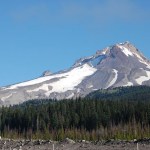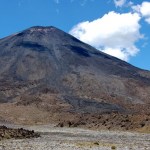Taal
Mt. Hood in Oregon, taken August 2008. Image by Erik Klemetti. Click on the image to see a larger version.
Quick news!
I'm not going to go into too much depth right now about the recent study published in Nature Geoscience on Mt. Hood in Oregon - I plan to talk about it more in a few weeks. Why is that? Well, the lead investigator on the study, Dr. Adam Kent of Oregon State University, is a friend of mine (and occasional Eruptions commenter) so I plan to get the details from him before posting. I was also peripherally associated with some of this work - mostly in the field acting as a pack…
A few very quick hits:
Ever-looming Mt. Rainier, with Tacoma, Washington in the foreground.
PHIVOLCS is pondering whether to lower the Alert Status at Taal back to Level 1. The volcano has been on Alert Level 2 for the past month after increasing signs of potential eruptive activity. However, seismicity is down at Taal, so PHIVOLCS will be sending a ground team to do a survey before deciding whether to lower the Alert Level. The heightened state of alert at Taal has lead to some people taking advantage of the populace, with little more than a fake text message to cause panic.
Just how tall…
News for Monday!
Ngauruhoe in New Zealand, showing the dark lava flows of basaltic andesite on the slopes of the young volcanic cone. Image by Erik Klemetti, taken January 2009.
A couple pieces of news from two Russian volcanoes on the Kamchatka Peninsula: (1) last week's report of activity at Gorely appears to be semi-substantiated with new photos on the KVERT website (Russian). The images from June 6 and 12 (2010) shows steam plumes coming from the volcano - one as tall as 500 meters. Now, this doesn't imply that an eruption occurred, but it might suggest activity on on the upswing. KVERT…
Have guests in town, so I'm a little busy, but you can hopefully keep entertained with the latest Smithsonian/USGS Global Volcanism Program Volcanic Activity Report.
Chile's Melimoyu volcano.
The highlights (not including Taal and Eyjafjallajökull) include:
Alaska's Cleveland volcano has been reduced to and alert status of "unassigned" (used when a volcano is not closely monitored so AVO doesn't know what exactly is "background") after a few weeks of activity. The same was done for the submarine volcano south of Sarigan in the Marianas Islands after no signs of activity since the eruption…
Volcano Island in the caldera lake at Taal.
The Philippine government is upping its concern about an eruption at Taal - and cracking down on tourists and resorts trying to get near Volcano Island in the volcano's caldera lake. Tourists are only allowed to take boat tours in the lake that go halfway to the island - which doubles as the most recently active vent at Taal - and if resorts on the lake bring tourists any closer, they may face repercussions from the government. Of course, this still isn't stopping tourists and natives from going to the island anyway. Now, one thing interesting to…
A partially-eroded scoria cone in the Taal volcano caldera.
As I mentioned earlier this week, PHIVOLCS has raised the Alert Status at Taal in the Philippines to 2 (out of 5) after increasing tremors and gas emissions from the volcano's crater lakes. Now, the Philippine government is taking this threat very serious, sending divers, helicopters, rescue equipment and medical teams to the area near the volcano in case an eruption occurs. Provincial officials in Batangas have asked 5,000 people living near Taal to voluntarily evacuate - however, as with many evacuations, people are reluctantly to…
The steaming vent area at Taal in the Philippines in September 1965, when the volcano produced a VEI 4 eruption.
The Philippine Institute of Volcanology and Seismology (PHIVOLCS) has raised the alert status at Taal to Level 2 (of 4) and officials in the Philippines are getting ready if the volcano does come back to life for the first time since 1977. Taal is a mere 48 km (30 miles) from Manila - the capital of the Philippines and home to over 21,000,000 people in the metro area of the city. This location made Taal one of the UN/IAVCEI Decade Volcanoes as a large eruption from the volcano…
Quick hits for a Monday morning (however, the week did have a good start).
Lava fountaining on March 27, 2010 at the Eyjafjallajokull-Fimmvörduháls eruption in Iceland.
The Eyjafjallajokull-Fimmvörduháls eruption is still going strong with two active fissure - and a lot of tourists poking around as well. If you watch the webcams closely, you can even see the cars and hikers trekking up near the erupting basaltic fissure (except today, as there seems to be a blizzard). Not to say that people are getting a little, well, nonchalant, but there is a story of serving meals cooked on lava up…
Ulawun Volcano, Papau New Guinea, one of the "Decade Volcanoes"
There was some discussion earlier about the so-called "Decade Volcanoes", so I thought I'd elaborate a bit on them (doubly so in light of certain other lists.) These volcanoes are defined by IAVCEI - the International Association of Volcanology and the Chemistry of the Earth's Interior - and are part of a program whose aim is
"to direct attention to a small number of selected, active volcanoes world-wide and to encourage the establishment of a range of research and public-awareness activities aimed at enhancing an…
Two volcanoes on the island of Luzon look like they might be primed for activity, at least according to PHILVOLCS, the Philippine Institute of Volcanology and Seismology. Both Mayon and Taal (above) are showing signs of increased seismicity. Only Mayon is actively steaming right now and the volcano had a mild ash eruption on August 10 as well. Officials in the Philippines have both volcanoes on Alert Level 1 (potential activity).
Taal is actually part of a bigger system that occupies a 15 by 20 km caldera. The island where most historic activity has occurred is made up of a…

